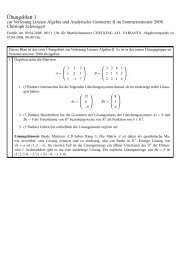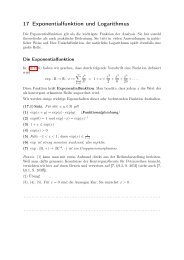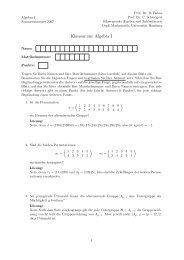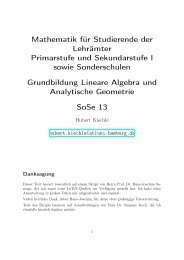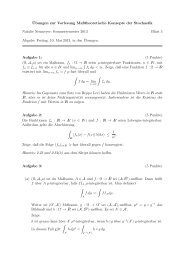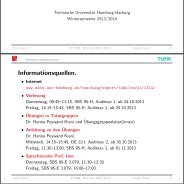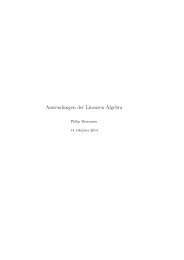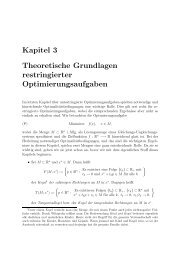pdf file
pdf file
pdf file
Create successful ePaper yourself
Turn your PDF publications into a flip-book with our unique Google optimized e-Paper software.
We discuss a first simple application.<br />
Corollary 3.1.7.<br />
Let H be a finite-dimensional Hopf algebra. If I ⊂ H is a right ideal and right coideal, then<br />
I = H or I = (0).<br />
Proof.<br />
As a right ideal, I is a right submodule of H. Similarly, as a right coideal, it is a right H-<br />
subcomodule. The condition of a Hopf module is inherited, so I is a Hopf submodule. The<br />
fundamental theorem implies<br />
I ∼ = I coH ⊗ K H .<br />
Taking dimensions, we find<br />
which only leaves I = (0) or I = H.<br />
dim K H ∙ dim K I coH = dim K I ≤ dim K H<br />
✷<br />
Definition 3.1.8<br />
1. Let H be a Hopf algebra. The K-linear subspace<br />
I l (H) := {x ∈ H | h ∙ x = ɛ(h)x for all h ∈ H}<br />
is called the space of left integrals of the Hopf algebra H. Similarly,<br />
I r (H) := {x ∈ H | x ∙ h = ɛ(h)x for all h ∈ H}<br />
is called the space of right integrals of H.<br />
2. Similarly, the subspace of H ∗<br />
CI l (H) := {φ ∈ H ∗ | (id H ⊗ φ) ◦ Δ H (h) = 1 H φ(h) for all h ∈ H}<br />
is called the space of left cointegrals. Right cointegrals are defined analogously.<br />
3. A Hopf algebra is called unimodular, if I l (H) = I r (H).<br />
Remarks 3.1.9.<br />
1. The space of left integrals is the space of left invariants for the left action of H on itself<br />
by multiplication. Alternatively, h ∈ I l (H) ⊂ H ∼ = Hom K (K, H) is a morphism of left<br />
H-modules. A similar statement holds for right integrals.<br />
2. Even if a Hopf algebra H is cocommutative, it might not be unimodular. For an example,<br />
see Montgomery, p. 17.<br />
3. Let H be finite-dimensional. Then φ ∈ H ∗ is a left integral for the dual Hopf algebra H ∗ ,<br />
if and only if<br />
μ ∗ (β, φ) = ɛ ∗ (β)φ for all β ∈ H ∗ .<br />
Using the definition of the bialgebra structure on H ∗ , this amounts to the equality<br />
β(h (1) ) ∙ φ(h (2) ) = β(1 H ) ∙ φ(h) for all β ∈ H ∗ and h ∈ H .<br />
Thus φ is an integral of H ∗ , if and only if<br />
i.e. if φ is a left cointegral.<br />
h (1) 〈φ, h (2) 〉 = 〈φ, h〉1 H for all h ∈ H ,<br />
55






